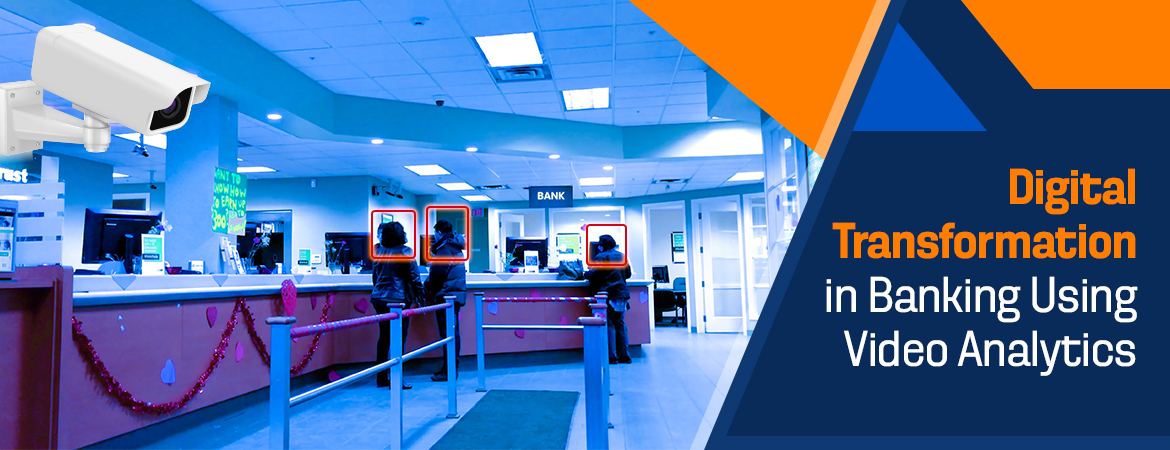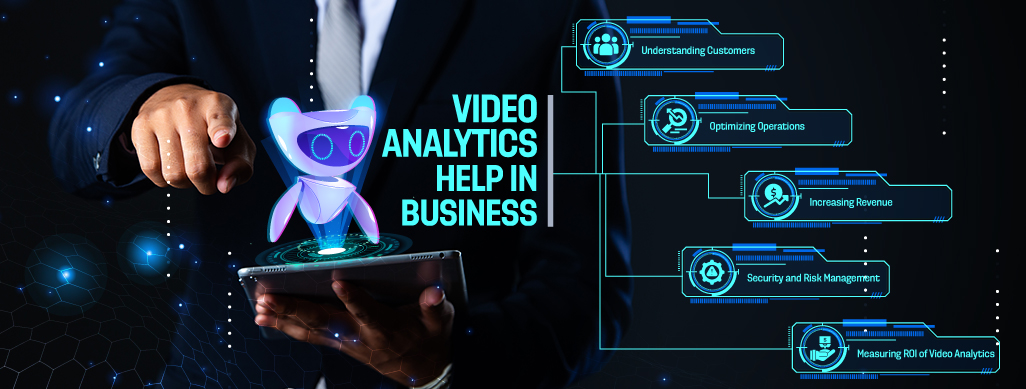
We use cookies to ensure that we give you the best experience on our website.
By using this site, you agree to our use of cookies. Find out more.
How video analytics is enabling banks to digitally transform key functions spanning safety, fraud detection, customer service optimization, efficiency improvements and regulatory compliance.

With the rapid digitization of the financial sector, banks are increasingly leveraging cutting-edge technologies to augment customer experience, streamline operations and gain strategic advantages. One such emerging innovation with huge potential impact is video analytics. By using computer vision and AI capabilities on surveillance camera feeds, video analytics can extract valuable insights for transforming banking processes. This blog discusses how video analytics is enabling banks to digitally transform key functions spanning safety, fraud detection, customer service optimization, efficiency improvements and regulatory compliance.
Video analytics refers to the capability of extracting meaningful insights from video data through computer vision and artificial intelligence techniques. At its core, video analytics involves taking video feeds from multiple surveillance cameras as input. Then advanced algorithms are applied to the video frames to recognize and analyze people, objects, activities and behaviors occurring over time.
Features like object detection, people counting, license plate recognition, facial recognition etc. fall under video analytics. It allows automating the monitoring, tracking and analytic of live and recorded video streams. The extracted metadata along with visualized analytics are then presented to users for further action. With continued training on large datasets, video analytics systems have reached high levels of accuracy in auto-detection of visual anomalies, patterns, security concerns and more across industries.
Here are some ways in which video analytics can help transform the banking sector:

Video analytics plays a huge role in enhancing the safety and security infrastructure of banks. With analytics, banks can monitor all their branches and ATM locations remotely round the clock. Any suspicious activity or security breach can be detected automatically from the numerous CCTV feeds covering the premises.
For example, video analytics has the capability to detect loitering, unattended objects, tailgating etc. and alert the concerned authorities immediately. The facial recognition feature also helps banks identify persons of interest instantly from recorded footage, which aids faster response during incidents. This early detection and notification go a long way in averting security threats.
Analytics also enables banks to restrict access to critical areas like vaults and cash counting zones only to authorized persons based on visual checks. This strengthens security in highly sensitive financial operations.
Video analytics is hugely beneficial for banks in detecting and preventing various types of frauds. The technology provides visual insights that can help uncover fraudulent activities which often go unnoticed otherwise. For example, analytics helps spot tampering of cash trays or skimming devices installed on ATM machines by monitoring live and recorded feeds. It also analyzes customer behavior at ATM lobbies and connects suspicious transactions to recognize potential stolen card usage in real-time.
Moreover, features like person identification come handy in pinpointing internal fraud by employees. Video data is also useful in investigations during fraud complaints by quickly retrieving relevant footage. Early detection enhances banks' ability to stop fraudulent transactions before large losses are incurred. Overall, video analytics acts as a powerful surveillance tool to recognize suspicious trends and patterns that can subsequently be addressed through preventive action.
Video analytics enables banks to enhance customer experience through various insights gained from footage analysis. Banks can use queue monitoring and customer tracking capabilities of analytics to determine optimal staffing levels at branches on a daily basis. This ensures quick attention is given to customers waiting in line and helps reduce wait times. Analytics also provides customer movement patterns that allow banks to rearrange their interior layouts for better workflow.
Features like sentiment analysis on customer facial expressions during interactions help banks determine if issues are being adequately addressed. Any detected gaps can then be plugged to improve service quality. Video data also enables banks to identify busiest hours and schedule employees accordingly. The overall benefit is improved convenience and satisfaction for customers through productivity optimization and superior customer service.
Video analytics is a powerful tool that allows banks to analyze operations and optimize processes for increased efficiency. By studying footfall patterns and queue dynamics over time through video, banks can streamline branch layouts for smoother customer movement. Analytics also provides useful insights into staffing needs. Banks can now deploy the right number of employees based on predicted customer volumes.
Additionally, remote equipment monitoring via cameras helps banks proactively address issues before they impact services. Analytics provides an easy way to check ATM health, maintenance needs from a centralized location. It also automates compliance checks that previously required extensive manual footwork. All these analytics-driven interventions help banks reduce costs while enhancing turnaround times. Branch operations become more seamless with better planning and resource allocation informed by video data.
Video analytics is an effective compliance management tool for banks. It helps banks closely monitor all customer and employee interactions to ensure strict adherence to regulatory protocols. Any footage of transactions and conversations can be seamlessly stored and retrieved as required to address customer disputes and auditing needs. With analytics-assisted facial recognition of persons and automatic tagging of video clips, it is easy to find specific incidents from years of archived recordings quickly. This provides irrefutable evidence for investigations.
Additionally, analytics allows remote video audits of branches to check for protocol conformity like following KYC procedures and following documented processes. It eliminates the need for frequent physical audits. Any detected deviations can be addressed to minimize compliance risks. Overall, video analytics strengthens the audit trail and enhances transparency for regulatory entities.
Video analytics services presents a compelling solution for banks to digitize and compete effectively in the current dynamic environment. Whether it is gaining real-time situational awareness, automating compliance checks or predicting asset maintenance needs, analytics on video data addresses critical pain points.
While data privacy and technical challenges need attention, leading banks have started reaping rewards from this transformative tech. As analytics capabilities advance further, video is poised to become the primary sensor driving automated intelligence across the entire banking value chain. Therefore, leveraging video and its embedded analytics fully has become imperative for banks to strategize their digital roadmap for future success.
Leave a Comment
Your email address will not be published.